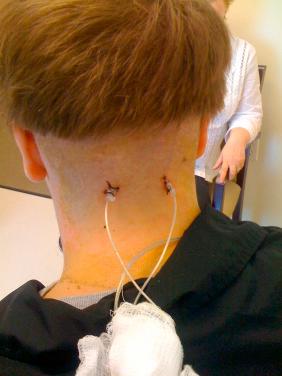Physical Address
304 North Cardinal St.
Dorchester Center, MA 02124
Occipital electrode placement into the subcutaneous tissues, innervated by and adjacent to the greater, lesser, and/or third occipital nerves from the C2-3 nerve roots for intractable occipital headache syndromes, continues to be an evolving methodology since the first cases were performed in 1993 and reported in 1999 ( ). These initial cases described a percutaneous method of wire electrode lead placement, which has been verified and modified among implanters for almost 25 years. Various paddle electrode designs have been implanted with more open techniques in an effort to minimize issues with migration and erosion and maximize tissue contact and electrical conduction into the subcutaneous tissues and adjacent affected nerves ( ). Using text and pictures, traditional percutaneous placement, paddle electrode implantation, and wireless electrode placement will be described and discussed.
Almost all potential candidates for occipital nerve stimulation (ONS) implantation undergo a percutaneous trial electrode placement of up to 1 week or longer to demonstrate initial efficacy and pain control to both the patient and the implanter, thereby justifying a permanent implant. This procedure is usually performed in an outpatient setting with short-acting and/or local anesthesia to minimize patient discomfort. Various insertion methods using Tuohy, Coude (Epimed), or angiocatheter needle devices have been used to place electrodes in the region of affected nerves. A distinct tissue plane is usually readily identifiable below the dermis and above the fascial layer of the upper cervical and skull base musculature. Insertion points can be midline to either side of the suboccipital region, lateral to midline, or lateral to beyond midline to cover the areas of innervated by the occipital nerve tributaries. Traditional starting insertion points has been at the level of C1, extending laterally; however, many implanters now angle the electrode tip toward the mastoid processes to maximize coverage of the various occipital nerve components ( ). Electrode placement typically is seated somewhat beyond the areas of maximal pain complaint in the occipital region so that, when tested for patient response to stimulation during the procedure, the wire(s) can be gently retracted toward the insertion point to maximize subcutaneous paresthesia coverage. The electrodes are then sutured to the skin, covered with watertight dressings for the trial period, and connected to the supplied transmitter ( Fig. 39.1 ).

Following the trial period, the electrodes are removed in the office setting, the patient is interviewed, and a decision is reached regarding permanent implantation. The wounds should be given at least a couple of weeks to heal before an incision is made in the area for permanent implantation to minimize risks of infection. Alternatively, permanent electrodes can be placed and tunneled with extension wires for a trial period, then converted to a total implant with generator placement (implantable pulse generator (IPG)).
Become a Clinical Tree membership for Full access and enjoy Unlimited articles
If you are a member. Log in here